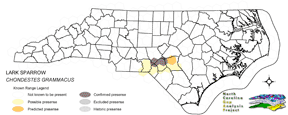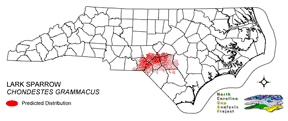
| Taxa: |
| Order: |
| Family: |
| Aves |
| Passeriformes |
| Emberizidae |
| NatureServe Global Rank: |
| NatureServe State (NC) Rank: |
| G5 |
| S1B,SZN |
| Federal Status: |
| NC State Status: |
| --- |
| SR |


| Land Unit |
| US Fish & Wildlife Service |
| US Forest Service |
| US National Park Service |
| US Department of Defense |
| NC State Parks |
| NC University System |
| NC Wildlife Res. Com. |
| NC Forest Service |
| NC Div. of Coastal Mgmt. |
| Local Governments |
| Non-Governmental Org. |
| Other Public Lands |
| Private Lands |
| GAP Status 1-2 |
| All Protected Lands |
| Statewide |
| Hectares |
| 109.98 |
| 0.00 |
| 49,883.22 |
| 0.00 |
| 639.90 |
| 0.00 |
| 20,559.24 |
| 138.33 |
| 0.00 |
| 257.49 |
| 182.79 |
| 0.00 |
| 240,010.38 |
| 1,686.60 |
| 71,062.11 |
| 311,781.33 |
| Acres |
| 271.77 |
| 0.00 |
| 123,264.10 |
| 0.00 |
| 1,581.23 |
| 0.00 |
| 50,802.98 |
| 341.82 |
| 0.00 |
| 636.27 |
| 451.68 |
| 0.00 |
| 593,078.45 |
| 4,167.68 |
| 175,598.26 |
| 770,428.29 |
| % of Dist. on |
| Prot. Lands |
| 0.2 % |
| 0.0 % |
| 70.2 % |
| 0.0 % |
| 0.9 % |
| 0.0 % |
| 28.0 % |
| 0.2 % |
| 0.0 % |
| 0.2 % |
| 0.2 % |
| 0.0 % |
| 0.0 % |
| 2.4 % |
| ----- |
| ----- |
| % of Dist. on |
| All Lands |
| < 0.1 % |
| 0.0 % |
| 16.0 % |
| 0.0 % |
| 0.2 % |
| 0.0 % |
| 6.6 % |
| < 0.1 % |
| 0.0 % |
| < 0.1 % |
| < 0.1 % |
| 0.0 % |
| 77.0 % |
| 0.5 % |
| ----- |
| ----- |
|
No confirmed nesting within the state; possible acccidental nesting in the piedmont (Pearson 1959, Potter et al. 1980). Requires extensive areas of dry, bare earth, often with rock outcrops, along with scattered saplings and herbaceous plants and shrubs. Also nests in fields with short grass cover, cultivated fields, clearcuts planted with pine (Nicholson 1997), along roadsides and in hedgerows (Kaufman 1996). Habitat often along edge of dry woods (Rising and Beadle 1996). In Tennessee, nests are often placed in a depression on the ground at the base of a plant that shades the nest (Nicholson 1997). In other parts of its range, nest may also be placed in a shrub or rock crevice. Feeds in flocks (Ehrlich et al. 1988). NATURE SERVE GLOBAL HABITAT COMMENTS: Open situations with scattered bushes and trees, prairie, forest edge, cultivated areas, orchards, fields with bushy borders, and savanna (AOU 1983). REPRODUCTIVE HABITAT COMMENTS: Usually nests on ground near plant or bush; sometimes nests in low tree or bush, 1-9 m above ground (Terres 1980). May use old nest of other bird (e.g., mockingbird, thrasher). |
| Code | Name | Description | NC Natural Heritage Program Equivalent |
| 63 | Coastal Plain Mesic Hardwood Forests | Beech dominated forests with white oak and northern red oak as possible co-dominants. Dry-mesic to mesic forests on slopes and small stream bottoms in the coastal plain. | Mesic Mixed Hardwood Forest, Basic Mesic Forests |
| 138 | Coastal Plain Dry to Dry-Mesic Oak Forests | Oak dominated forests of the coastal plain. Includes white oak forests with water oak or northern red oak and hickories as co-dominants. | Dry Mesic Oak Hickory Forest, Basic Oak Hickory Forest, Dry Oak Hickory Forest |
| 97 | Mesic Longleaf Pine | Longleaf pine woodlands without a major scrub oak component. Slash or loblolly pines may be present as well. | Mesic Pine Flatwoods |
| 42 | Xeric Longleaf Pine | Sandhills including a range of longleaf pine density from predominantly wiregrass, scrub oak dominated to true longleaf pine woodland. This does not include mesic or saturated flatwood types. | Xeric Sandhill Scrub, Pine/Scrub Oak Sandhill, Coastal Fringe Sandhill |
| 46 | Xeric Oak - Pine Forests | Mixed forest dominated by yellow pines with white or northern red oaks co-dominating. | Pine Oak Heath |
| 232 | Xeric Pine-Hardwood Woodlands and Forests | Mixed forest dominated by yellow pines with drier oaks including southern red, post, and chestnut oaks. | Dry Oak Hickory Forest |
| 230 | Piedmont Mesic Forest | American Beech - Red Oak - White Oak Forests. | Mesic Mixed Hardwood |
| 383 | Piedmont Mixed Successional Forest | Generally loblolly mixed with successional hardwoods. Sweetgum, tulip poplar and red maple are common co-dominants in these successional forests. | No equivalent |
| 228 | Piedmont Dry-Mesic Oak and Hardwood Forests | Primarily oak dominated forests, white oak is often dominant, with co-dominants including . Also represented by sweetgum and tulip poplar dominated forests. | Dry Mesic Oak Hickory Forest, Basic Oak Hickory Forest, Dry Oak Hickory Forest |
| 222 | Piedmont Dry-Mesic Pine Forests | Loblolly dominated forests resulting from succession following clearing. This type occurs on all moisture regimes following disturbance with the exception of the extremely xeric sites. | No equivalent |
| 382 | Dry Mesic Oak Pine Forests | Mixed forests of the coastal plain and piedmont. Includes loblolly pine with white, southern red and/or post oak and loblolly with water oak. On basic sites of the piedmont, eastern red cedar may co-occur with post, black, and blackjack oaks. | Dry Mesic Oak Hickory Forest, Xeric Hard Pan Forest, Chestnut Oak Forest, Dry Mesic Oak Hickory Forest, Dry Oak Hickory Forest |
| 220 | Piedmont Xeric Pine Forests | Dry to xeric pine forests dominated by Virginia pine, shortleaf pine or Eastern Red Cedar. | Pine Oak Heath |
| 226 | Piedmont Xeric Woodlands | Generally post and blackjack oak dominated woodlands. White ash and pignut hickory can be found in combination with Eastern red cedar on glades. | Xeric Hardpan Forest |
| 20 | Coniferous Regeneration | Regenerating pine stands. Predominantly loblolly pine, but slash and longleaf stands occur as well. | No equivalent |
| 21 | Coniferous Cultivated Plantation (natural / planted) | Managed pine plantations, densely planted. Most planted stands are loblolly, but slash and longleaf occur as well. | No equivalent |
| 51 | Deciduous Cultivated Plantation | Planted deciduous trees. Includes sweetgum and sycamore plantations. | No equivalent |
| 36 | Successional Deciduous Forests | Regenerating deciduous trees with a shrub stature. Commonly dominated by sweetgum, tulip poplars and maples. | No equivalent |
| 180 | Agricultural Crop Fields | Farm fields used for row crops. | No equivalent |
| 205 | Agricultural Pasture/Hay and Natural Herbaceous | Farm fields used for pasture grass or hay production, as well as old fields dominated by native and exotic grasses. | No equivalent |
| 202 | Residential Urban | Includes vegetation interspersed in residential areas. Includes lawns, mixed species woodlots, and horticultural shrubs. Vegetation accounts for between 20 - 70% of the cover. | No equivalent |
|
Carter, M., G. Fenwick, C. Hunter, D. Pashley, D. Petit, J. Price, and J. Trapp. 1996. Watchlist 1996:For the future. Field Notes 50(3):238-240.
Kaufman K. 1996. Lives of North American Birds. Boston, New York: Houghton Mifflin Company. Nicholson CP. 1997. Atlas of the breeding birds of Tennessee. Knoxville: University of Tennessee Press. Oberholser, H.C. 1974. The bird life of Texas. 2 vols. Univ. of Texas Press, Austin. Pough, R. H. 1957. Audubon Western Bird Guide. Doubleday. 316 pp. Pearson, T.G. 1959. Birds of North Carolina. Raleigh, NC: Bynum Printing Company. Godfrey, W.E. 1966. The birds of Canada. National Museums of Canada. Ottawa. 428 pp. Potter, E. F., J. F. Parnell, and R. P. Teulings. 1980. Birds of the Carolinas. Univ. North Carolina Press, Chapel Hill. 408 pp. Terres, J.K. 1980. The Audubon Society encyclopedia of North American birds. Alfred A. Knopf, New York. American Ornithologists' Union (AOU), Committee on Classification and Nomenclature. 1983. Check-list of North American Birds. Sixth Edition. American Ornithologists' Union, Allen Press, Inc., Lawrence, Kansas. Ehrlich, P.R., D.S. Dobkin, and D. Wheye. 1988. The birder's handbook:a field guide to the natural history of North American birds. Simon and Shuster, Inc., New York. xxx + 785 pp. Droege, S., and J.R. Sauer. 1990. North American Breeding Bird Survey, annual summary, 1989. U.S. Fish and Wildlife Service, Biological Report 90(8). 22 pp. |
For more information please contact them at:
NC-GAP Analysis Project
Dept. of Zoology, NCSU
Campus Box 7617
Raleigh, NC 27695-7617
(919) 513-2853
www.basic.ncsu.edu/ncgap